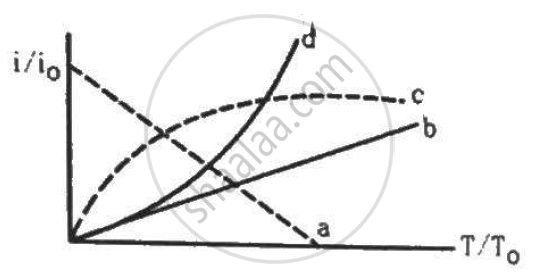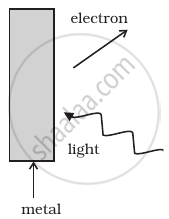Advertisements
Advertisements
प्रश्न
The constant A in the Richardson−Dushman equation for tungsten is 60 × 104 A m−2K−2. The work function of tungsten is 4.5 eV. A tungsten cathode with a surface area 2.0 × 10−5 m2 is heated by a 24 W electric heater. In steady state, the heat radiated by the heater and the cathode equals the energy input by the heater and the temperature becomes constant. Assuming that the cathode radiates like a blackbody, calculate the saturation current due to thermions. Take Stefan's Constant = 6 × 10−8 W m−2 K−1. Assume that the thermions take only a small fraction of the heat supplied.
उत्तर
Given:-
A = 60 × 104 A m−2 K−2
Work function of tungsten, ϕ = 4.5 eV
Stefan's Constant, σ = 6 × 10−8 W m−2 K−1
Surface area of tungsten cathode, S = 2.0 × 10−5 m2
Boltzmann's Constant, k = 1.38× 10−23 J/K
Heat supplied by the heater, H = 24 W
The cathode acts as a black body; thus, its emissivity is 1.
According Stefan's Law:-
The power (P) radiated by a blackbody with surface area (A) and temperature (T),
\[P = \sigma A T^4 \]
\[ \Rightarrow T^4 = \frac{P}{\sigma A}\]
\[ \Rightarrow T^4 = \frac{24}{(6 \times {10}^{- 8} ) \times (2 \times {10}^{- 5} )}\]
\[ \Rightarrow T^4 = 2 \times {10}^{13} K = 20 \times {10}^{12} K\]
\[ \Rightarrow T = 2 . 1147 \times {10}^3 = 2114 . 7 K\]
According to the Richard-Dushmann equation, emission current,
\[i = AS T^2 e^{- \phi/KT} \]
\[i = 6 \times {10}^5 \times 2 \times {10}^{- 5} \times (2114 . 7 )^2 \times e^\frac{- 4 . 5 \times 1 . 6 \times {10}^{- 19}}{1 . 38 \times {10}^{- 23} \times 2114 . 7} \]
\[i = 1 . 03456 \times {10}^{- 3} A \approx 1 . 0\text{ mA}\]
APPEARS IN
संबंधित प्रश्न
Why should gases be insulators at ordinary pressures and start conducting at very low pressures?
How will the thermionic current vary if the filament current is increased?
Would you prefer a material with a high melting point or a low melting point to be used as a cathode in a diode?
Let i0 be the thermionic current from a metal surface when the absolute temperature of the surface is T0. The temperature is slowly increased and the thermionic current is measured as a function of temperature. Which of the following plots may represent the variation in (i/i0) against (T/T0)?

The anode of a thermionic diode is connected to the negative terminal of a battery and the cathode to its positive terminal.
Define the term "Threshold frequency", in the context of photoelectric emission.
The work function of aluminum is 4⋅2 eV. If two photons each of energy 2⋅5 eV are incident on its surface, will the emission of electrons take place? Justify your answer.
The wavelength λe of an electron and λp of a photon of same energy E are related by
If a light of wavelength 330 nm is incident on a metal with work function 3.55 eV, the electrons are emitted. Then the wavelength of the wave associated with the emitted electron is (Take h = 6.6 × 10–34 Js)
Why do metals have a large number of free electrons?
What do you mean by electron emission? Explain briefly various methods of electron emission.
In which case is electron emission from a metal not known?
Consider Figure for photoemission.

How would you reconcile with momentum conservation? Note light (photons) have momentum in a different direction than the emitted electrons.
Give an example each of a metal from which photoelectric emission takes place when irradiated by
- UV light
- visible light.
Name the factors on which photoelectric emission from a surface depends.
The work function of a metal is 2.31 eV. Photoelectric emission occurs when the light of frequency 6.4 × 1014 Hz is incident on the metal surface. Calculate
- the energy of the incident radiation,
- the maximum kinetic energy of the emitted electron and
- the stopping potential of the surface.
